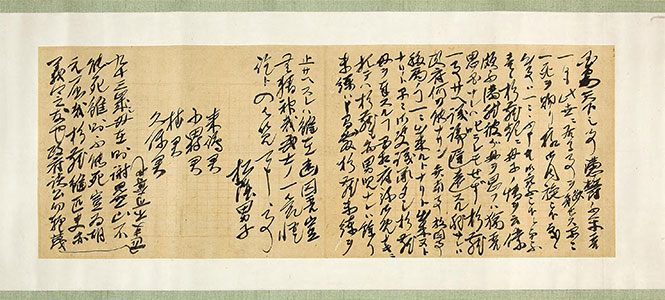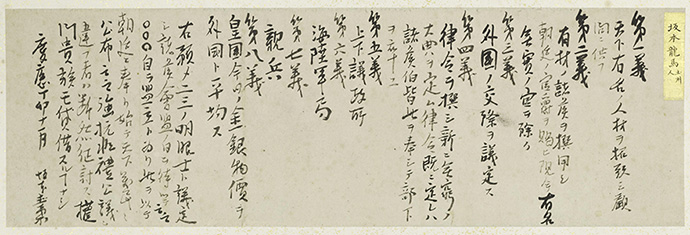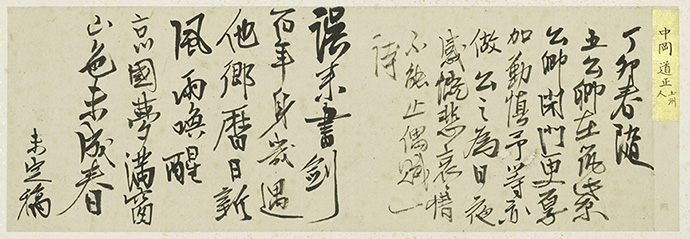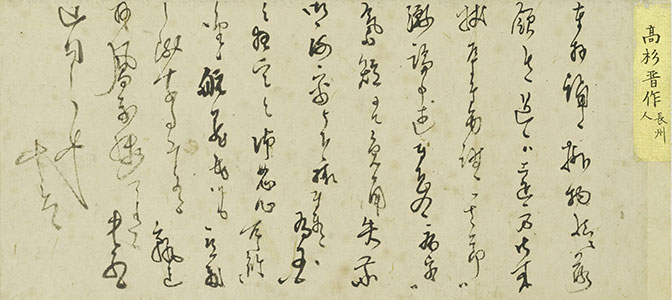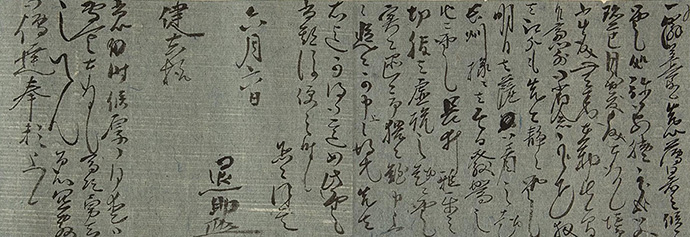- Top
- > Part 2: Modern era
- >Chapter 1: People at the end of the Edo period and the Meiji Restoration (1)
Chapter 1 People at the end of the Edo period and the Meiji Restoration (1)
YOSHIDA Shoin, 1830-1859
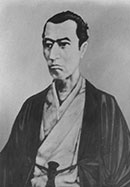 A thinker and an educator at the end of the Edo period. A feudal retainaer of the Choshu Domain. He desired to study in Europe and the Americas, and requested permission to accompany the naval squadron commanded by Commodore Matthew Calbraith Perry anchored at Shimoda in 1854, but was refused. He turned himself in and was imprisoned. After he was discharged, he started Shoka Sonjuku (a private school) at his house in Hagi. Takasugi Shinsaku, Ito Hirobumi, Yamagata Aritomo were included in his student. He was executed in the Ansei Purge.
A thinker and an educator at the end of the Edo period. A feudal retainaer of the Choshu Domain. He desired to study in Europe and the Americas, and requested permission to accompany the naval squadron commanded by Commodore Matthew Calbraith Perry anchored at Shimoda in 1854, but was refused. He turned himself in and was imprisoned. After he was discharged, he started Shoka Sonjuku (a private school) at his house in Hagi. Takasugi Shinsaku, Ito Hirobumi, Yamagata Aritomo were included in his student. He was executed in the Ansei Purge.
37 Yoshida Shoin shokan, March, 1859[Inoue Kaoru Papers: 634-2]
This letter was written by Shoin to those who were close to Shoin (Kijima Matabee, Odamura Inosuke, Katsura Kogoro (later Kido Takayoshi), Kubo Seitaro) while he was imprisoned in Noyamagoku jail for his radical remarks and deeds concerning the Treaty of Amity and Commerce between the United States and Japan. He expresses himself on how he was ready to be executed and writes about his beloved student, Irie Kuichi (a.k.a. Sugizo), who was imprisoned due to failure in the operation to carry out the Doctrine of expelling foreigners directed by Shoin. While he expresses his discontentment with Irie, who keeps asking for release to take care of his aged mother even in such a national emergency, he tries to understand him.
Continuing a handwritten letter in the margin at the top
In olden times, people often used the margins at the top of a letter to continue writing on the same sheet of paper rather than using a second sheet, and this practice is known as kaeshigaki (e.g., Shimoda Utako). Of course, this assumes that a margin had been left at the top of the letter in the first place. In cases where even more space was needed, sometimes kaeshigaki continued into the space between earlier lines of text (e.g., Hosokawa Gracia).
Yoshida Shoin's letters show that he added postscripts in available space, but written upside down relative to the body of the text. This might be considered one form of kaeshigaki.
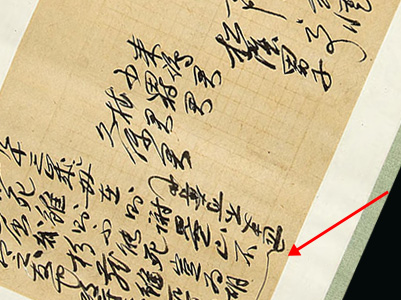
SAKAMOTO Ryoma, 1835-1867
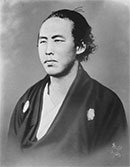 A patriot at the end of the Edo period. His real given name was Naonari but his popular name was Ryoma. He was born in Tosa. After he left his domain and wandered through the provinces, he became a student of Katsu Kaishu in Edo and had his eyes opened for the opening of Japan to foreign countries. While he formed Kameyama-shachu (later Kaientai) and operated a trading business, he mediated between Saigo Takamori and Kido Takayoshi to enact the Satsuma-Choshu Alliance and realized taisei hokan (return of power to the Emperor), but was assassinated at Oumiya in Kyoto together with Nakaoka Shintaro.
A patriot at the end of the Edo period. His real given name was Naonari but his popular name was Ryoma. He was born in Tosa. After he left his domain and wandered through the provinces, he became a student of Katsu Kaishu in Edo and had his eyes opened for the opening of Japan to foreign countries. While he formed Kameyama-shachu (later Kaientai) and operated a trading business, he mediated between Saigo Takamori and Kido Takayoshi to enact the Satsuma-Choshu Alliance and realized taisei hokan (return of power to the Emperor), but was assassinated at Oumiya in Kyoto together with Nakaoka Shintaro.
38-1 Shin seifu koryo hassaku (from Boyucho), November, 1867[Ishida Eikichi Papers: 1-5]
Suggested regime of the new nation drafted by Ryoma based on “Senchu Hassaku” and was shown to representatives of the Tosa Domain. “Senchu Hassaku” was said to have been created by Goto Shojiro, a feudal retainaer of the Tosa Domain, with Ryoma in 1867 when Goto suggested taisei hokan (return of power to the Emperor) to Yamauchi Yodo, the former lord of the domain. It included a proposal for taisei hokan, parliamentary system, bureaucracy, diplomacy, selection of the constitution and military administration which formed the foundation the new Meiji government. The petition for taisei hokan submitted from the Tosa Domain to the Shogunate in October of the same year was created based on this “Senchu Hassaku”.
NAKAOKA Shintaro, 1838-1867
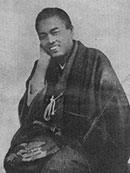 A patriot at the end of the Edo period. He was born in Tosa. He joined to form Tosa Kinno-to, but being suppressed by the Tosa Domain, he left the domain and devoted himself to the conclusion of the Satsuma-Choshu Alliance with Sakamoto Ryoma. Later he was pardoned for the sin of fleeing from the domain and formed Rikuentai which followed Ryoma’s Kaientai, and became a captain. But he was assassinated at Oumiya with Ryoma.
A patriot at the end of the Edo period. He was born in Tosa. He joined to form Tosa Kinno-to, but being suppressed by the Tosa Domain, he left the domain and devoted himself to the conclusion of the Satsuma-Choshu Alliance with Sakamoto Ryoma. Later he was pardoned for the sin of fleeing from the domain and formed Rikuentai which followed Ryoma’s Kaientai, and became a captain. But he was assassinated at Oumiya with Ryoma.
38-2 Nakaoka Shintaro hisseki (from Boyucho), January, 1867[Ishida Eikichi Papers: 1-15]
Nakaoka Shintaro went to Dazaifu in January 1867 and informed the death of Emperor Komei to Sanjo Sanetomi, Sanjonishi Suetomo, Higashikuze Michitomi, Shijo Takauta and Mibu Motonaga. Seven nobles were expelled from Kyoto in the Coup of August 18th, 1863, but these five nobles were in Dazaifu at that time. It is the shichigon zekku (a Chinese poem of four lines, each of seven characters) Nakaoka read at that time.
TAKASUGI Shinsaku, 1839-1867
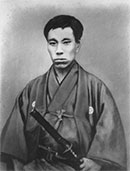 A patriot at the end of the Edo period. He was born in Choshu. He studied at Shoka Sonjuku (a private school) and joined sonno-joi undo (lit. movement to revere the Emperor and expel the barbarians) and took part in the fire attack on the British legation. In 1863, he established the Kiheitai army to defend Shimonoseki, and repelled the Shogunate force at the Second Choshu Expedition, but died of illness before the Meiji Restoration.
A patriot at the end of the Edo period. He was born in Choshu. He studied at Shoka Sonjuku (a private school) and joined sonno-joi undo (lit. movement to revere the Emperor and expel the barbarians) and took part in the fire attack on the British legation. In 1863, he established the Kiheitai army to defend Shimonoseki, and repelled the Shogunate force at the Second Choshu Expedition, but died of illness before the Meiji Restoration.
38-3 Takasugi Shinsaku shokan (from Boyucho), [ca. 1865][Ishida Eikichi Papers: 1-7]
Since it has the signature “Tani”, it was probably written after his name was changed to “Tani Senzo” at the domain’s order in September 1865. He apologizes to Ishida, who was of Takasugi’s age, for “being indignant in discussion” and said, “I apologize for being short-tempered due to my illness”.
 Boyucho
Boyucho
This is a scroll made by Ishida Eikichi with 19 writings including letters and manuscripts of kanshi (Chinese poems) written by Ishida’s 15 friends including Takeda Kounsai, Kido Takayoshi, Sakamoto Ryoma, Nakaoka Shintaro, Takasugi Shinsaku.
Ishida was born in Tosa and was a patriot who was active in kinno undo (movement to revere the Emperor). He joined the Tenchu-gumi, and later he joined the Kiheitai Army and Kaientai, and took part in the Boshin War. He served the new government after the Meiji Restoration and became the Vice Minister of the Ministry of Agriculture and Commerce, the governor of Kochi Prefecture. He was created a Baron in 1896 and became a member of the House of Peers.
Although it is not clear what motivated Ishida to collect these materials and make this scroll, it is assumed that the research he carried out during his tenure as a governor of Kochi Prefecture in 1893, by special order of the Home Ministry on those who had rendered distinguished services for the Restoration, had affected him. Also in 1897, he devoted himself to building a monument to 23 patriots of the Tosa Kinno-to who were executed on September 5, 1864. At that time, Ishida was collecting materials on the 23 patriots and wrote a reminiscent talk about them, being active in telling people about his comrades and their achievements during their lifetimes.
In the 1880s, when society was getting settled, not only Ishida but also vassals of the former Shogunate and those who were engaged in domain offices started listening, writing and remembering about the movement at the end of the Edo period and the Meiji Restoration.
Ishida’s documents (Ishida Eikichi Papers) include records such as “Kainan junnanshi ryakuden” which is about the said 23 patriots and “Yamato nikki”, material concerning Tenchu-gumi which show Ishida’s desire to pass on the great achievements of the patriots during the Restoration.

<Other people whose writings were included in “Boyucho”>
FUJITA Toko
TAKEDA Kounsai, 1803-1865
A feudal retainaer of the Mito Domain at the end of the Edo period. He played an active role as a reformist of the Mito Domain, and became a leader of the Tengu-to, a radical sonno-joi group (lit. supporters of the doctrine of revering the Emperor and expelling the barbarians). He attempted to go to Kyoto but surrendered to the Kanazawa Domain and was executed.
Kido Takayoshi
TAKAMATSU Tsurukichi, 1807-1876
Confucian scholar at the end of the Edo period. He opened a private school in Tosa and produced Nakaoka Shintaro, Ishida Eikichi and others. He married Chizuru, Sakamoto Ryoma’s elder sister. His eldest son succeeded as the head of the Sakamoto Family, and his second son succeeded to Ryoma’s Family.
MASAKI Tetsuma, 1834-1863
A feudal retainaer of the Tosa Domain at the end of the Edo period. He joined Tosa Kinno-to and worked for reform of domain politics, but aroused the anger of Yamauchi Yodo, the former lord of the domain, and was ordered to commit suicide by falling on his sword.
OYAMA Tsunayoshi, 1825-1877
A feudal retainaer of the Satsuma Domain at the end of the Edo period, and a bureaucrat. He took a central role in the purge of radical retainers in the Teradaya Incident. After the Restoration, he supported Saigo Takamori at the Satsuma Rebellion while he was a prefectural governor, and was executed.
KADOTA Tamenosuke, 1838-1867
A feudal retainaer of the Tosa Domain at the end of the Edo period. He joined Tosa Kinno-to and was acquainted with Sakamoto Ryoma as a student of Katsu Kaishu.
KAWAKAMI Gensai, 1834-1872
A feudal retainaer of the Kumamoto Domain at the end of the Edo period. He was called “Hitokiri Gensai” for what he did after he joined sonno-joi group (lit. supporters of the doctrine of revering the Emperor and expelling the barbarians) including assassinating Sakuma Shozan. He was arrested on suspicion of forming a plot against the government in 1870, and was executed.
YOSHIGA Makita, 1844-1868
He was from the Choshu Domain. He went to Echigo in the Boshin War but died of illness.
DATE Chihiro, 1802-1877
A feudal retainaer of the Wakayama Domain at the end of the Edo period, a scholar of Japanese classical literature and a poet. He is famous for his history book, “Taisei Santenko”. He was the father of Mutsu Munemitsu.
HASEGAWA Tetsunoshin, 1822-1871
A patriot of the sonno-joi group (lit. the supporters of the doctrine of revering the Emperor and expelling the barbarians) at the end of the Edo period. He was from Echigo Province. He fought in the Kimmon Incident and the Boshin War.
DAIRAKU Gentaro, 1834-1871
A feudal retainaer in the Choshu Domain at the end of the Edo period. He promoted sonno-joi undo (lit. movement to revere the Emperor and expel the barbarians) with Takasugi Shinsaku and others andstarted a private school, Seizan Shoya. After the Restoration, he was implicated in the assassination attempt of Omura Masujiro and was confined. He escaped later but was assassinated in 1871 in Kurume where he was hiding.
ITAGAKI Taisuke, 1837-1919
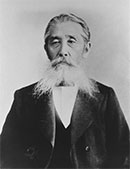 A politician at the end of the Edo period and in the Meiji era. He was from the Tosa Domain. He promoted the anti-Shogunate movement and fought in the Boshin War and became sangi (councilor) in the new government. Colliding with Okubo Toshimichi and his Sympathizers over the Conquer Korea debate, he resigned his post of sangi with Saigo Takamori and others. He submitted a petition calling for the establishment of a national assembly elected by the people and insisted on demands for democratic rights. He established the Jiyu-to (Liberal Party) in 1881 and became a leader. He was attacked by an assassin while canvassing in Gifu City. He was said to have shouted when he was attacked, “Itagaki may die but liberty never will!”
A politician at the end of the Edo period and in the Meiji era. He was from the Tosa Domain. He promoted the anti-Shogunate movement and fought in the Boshin War and became sangi (councilor) in the new government. Colliding with Okubo Toshimichi and his Sympathizers over the Conquer Korea debate, he resigned his post of sangi with Saigo Takamori and others. He submitted a petition calling for the establishment of a national assembly elected by the people and insisted on demands for democratic rights. He established the Jiyu-to (Liberal Party) in 1881 and became a leader. He was attacked by an assassin while canvassing in Gifu City. He was said to have shouted when he was attacked, “Itagaki may die but liberty never will!”
39 Itagaki Taisuke shokan, June 6, 1862[Modern Japanese Political History Materials Room Collection: 69-1-3]
This letter was written by Itagaki at the Edo hantei (residence maintained by a daimyo in Edo) to Kataoka Kenkichi who was from the same town as Itagaki and was a feudal retainaer of the Tosa Domain. In the letter, he says “The rumor that Nagai Uta (feudal retainaer in the Choshu Domain) committed suicide by falling on his sword seems to be false.” In March 1861, Nagai submitted a petition on the Opening of Japan and kobu gattai (Reconciliation between the Imperial Court and the Shogunate) to the domain lord Mori Takachika which once was adopted as the policy of the Choshu Domain. However, he lost his power due to the objection of the sonno-joi group (lit. the supporters of the doctrine of revering the Emperor and expelling the barbarians) in the domain including Kido Takayoshi, and was ordered to commit suicide by falling on his sword. This letter was written in June 1862 after Nagai had lost his power but before he committed suicide by falling on his sword in February of the following year.
SANJO Sanetomi, 1837-1891
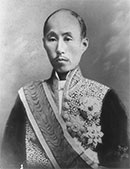 A court noble at the end of the Edo period and in the Meiji era, and also a politician. He planned to reverse the superior-subordinate relationship between the Imperial Court and the Shogunate by impeaching a court noble, Iwakura Tomomi, who supported kobu gattai (Reconciliation between the Imperial Court and the Shogunate), but was defeated by the Kobu gattai group centered on the force of Aizu and Satsuma and escaped to Choshu with other six court nobles (Shichikyo-ochi (decline of Seven nobles)). After the Meiji Restoration, he served as dajo daijin (Grand Minister of State), lord keeper of the Privy Seal, etc.
A court noble at the end of the Edo period and in the Meiji era, and also a politician. He planned to reverse the superior-subordinate relationship between the Imperial Court and the Shogunate by impeaching a court noble, Iwakura Tomomi, who supported kobu gattai (Reconciliation between the Imperial Court and the Shogunate), but was defeated by the Kobu gattai group centered on the force of Aizu and Satsuma and escaped to Choshu with other six court nobles (Shichikyo-ochi (decline of Seven nobles)). After the Meiji Restoration, he served as dajo daijin (Grand Minister of State), lord keeper of the Privy Seal, etc.
40 Sanjo Sanetomi shokan, July 9, 1873[Modern Japanese Political History Materials Room collection: 265-1-2]
This letter was written by Sanjo as dajo daijin (Grand Minister of State) to Iwakura Tomomi as u daijin (Minister of the Right). Iwakura was visiting Europe and the Americas at the time as an extraordinary and plenipotentiary ambassador leading the delegation. In the letter, Sanjo explains about the situation after the Imperial Palace was burned down. Although the Akasaka Detached Palace was a temporary palace after the Imperial Palace was burnt down on May 5, 1873, it was difficult to maintain dignity inside and outside the country. Sanjo wrote in the letter that when the Imperial Palace was to be rebuilt, residents of foreign Emperors visited by the delegation should be mentioned.
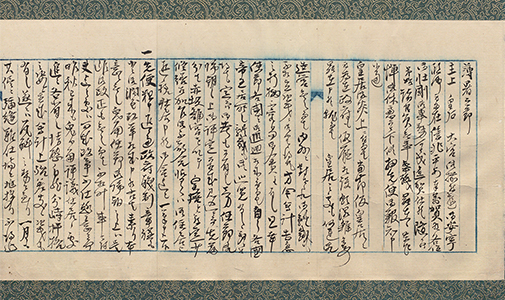
IWAKURA Tomomi, 1825-1883
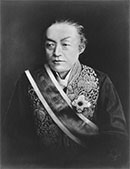 A court noble at the end of the Edo period and in the Meiji era, and also a politician. He first worked for kobu gattai (Reconciliation between the Imperial Court and the Shogunate) but later he joined Satsuma and Choshu’s anti-Shogunate group and realized the Restoration of Imperial Rule. He served as consultant and u daijin (Minister of the Right) in the Meiji government. He toured European countries and the Americas leading the “Iwakura Mission” as ambassador extraordinary and plenipotentiary. After he returned, he worked on the theory of priority of domestic administration and opposed the Conquer Korea debate.
A court noble at the end of the Edo period and in the Meiji era, and also a politician. He first worked for kobu gattai (Reconciliation between the Imperial Court and the Shogunate) but later he joined Satsuma and Choshu’s anti-Shogunate group and realized the Restoration of Imperial Rule. He served as consultant and u daijin (Minister of the Right) in the Meiji government. He toured European countries and the Americas leading the “Iwakura Mission” as ambassador extraordinary and plenipotentiary. After he returned, he worked on the theory of priority of domestic administration and opposed the Conquer Korea debate.
41 Iwakura Tomomi shokan, July 2, 1873[Sanjo Family Papers (Letters) 191-49]
This letter was written by Iwakura, who was visiting Europe and the Americas leading the Mission, to Sanjo Sanetomi who was dajo daijin (Grand Minister of State) and was holding the fort. From the date, it seems to have been written in Geneva. It says he only has one more country to visit. It also says he was aghast at the news of the Imperial Palace being burned down and showed concern for Sanjo and others who were facing difficulties. Iwakura left Marseille on July 20th and returned to Japan.
Prince Arisugawa Taruhito, 1835-1895
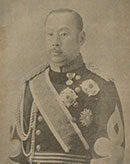 Arisugawa-no-miya 9th Imperial Prince. He insisted on the “Revere the Emperor and expel the barbarians” doctrine at the end of the Edo period. He became the president of the Meiji government. He was a commander-in-chief of the government army in the Boshin War and later served as Army General and chief of the general staff.
Arisugawa-no-miya 9th Imperial Prince. He insisted on the “Revere the Emperor and expel the barbarians” doctrine at the end of the Edo period. He became the president of the Meiji government. He was a commander-in-chief of the government army in the Boshin War and later served as Army General and chief of the general staff.
42 Arisugawanomiya Taruhito shinno shokan, July 24, 1876[Mutsu Munemitsu Papers: 3-10]
This letter was written by Prince Arisugawa, who was the chairman of the Chamber of Elders, to Mutsu Munemitsu and Yanagiwara Sakimitsu, who were members of the Chamber of Elders. The banquet that is said to have been held at the Shiba Detached Palace with Sanjo Sanetomi, Iwakura Tomomi, Kido Takayoshi, Okubo Toshimichi and Ito Hirobumi, is thought to have been a party held in appreciation of the Emperor Meiji’s travel to Tohoku and Hokkaido in 1876.



